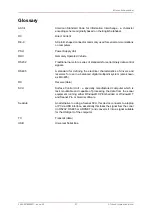
Micron Echosounder
0650-SOM-00001, Issue: 02
19
© Tritech International Ltd.
Appendix A. CHIRP Signal Processing
There are several advantages of
Tritech International Ltd
Digital Sonar Technology (DST)
which allows the use of CHIRP signal processing technology to improve the images
generated by the sonar.
In monotonic (single frequency burst) sonar, the range resolution is determined by the length
of the transmitted pulse. The smaller the pulse, the greater the resolution achievable and
vice-versa. The smallest pulse length is typically 50 micro seconds and velocity of sound in
water is approximately 1500 metres/second which gives a range resolution of 37.5mm. This
result determines the ability to resolve separate targets.
T1
T2
Combined echo
(seen by the receiver)
Target 2 echo
Target 1 echo
Transmitted Pulse
Sonar range
resolution
Target
seperation
Time
Target
Seperation
Using the example above, if two targets are less than 37.5mm apart then they cannot be
distinguished from each other. The net effect is that the system displays a single large target,
rather than multiple smaller targets.
CHIRP signal processing overcomes these limitations by sweeping the frequency within the
burst over a broad range of frequencies throughout the duration of transmission pulse. This
creates a signature acoustic pulse - the sonar knows what was transmitted and when. Using
pattern matching technology, it can now look for its own unique signature being echoed back
from targets.
Transmitted signal
Transmitter
circuit
Receiver
circuit
Received decoded signal
pulse duration
In a CHIRP system, the critical factor determining range resolution is the bandwidth of the
CHIRP pulse which means the range resolution is given by:
Range resolution =
velocity of sound
2 x bandwidth
The bandwidth of a typical
Tritech International Ltd
CHIRP system is 50kHz.
With velocity of sound in water of 1500m/s this gives a new range resolution of 15mm.
This time, when two acoustic echoes overlap, the signature CHIRP pulses do not merge into
a single return. The frequency at each point of the pulse is different, and the sonar is able
to resolve the two targets independently.



































